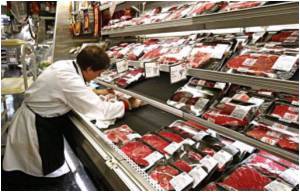- Higher intake of red meat and poultry is associated with increased risk of developing diabetes
- The risk is partially attributed to the higher content of heme iron in red meat and poultry
- Replacing red meat and poultry with fish and shellfish can reduce the risk of diabetes
The study data were from the Singapore Chinese Health Study conducted between 1993 and 1998. The study recruited 63,257 adults between the age of 45-74 years. The study participants were followed for an average of about 11 years.
How Red Meat and Poultry Increase Risk of Diabetes
To understand the underlying mechanism for the role of red meat and poultry in the development of diabetes, the research team investigated the associated between dietary heme-iron content from all meats and the risk of diabetes. The team found a dose-dependent positive association between heme-iron content and diabetes.
The association between red meat and diabetes was high even after adjusting heme-iron content, suggesting that other chemicals present in red meat could be responsible for increasing diabetes risk. There was no association between poultry intake and diabetes risk, suggesting that the risk was attributable to the heme-iron content in poultry.
The findings of the study suggest that increased intake of red meat and increase in the heme iron content of diet could increase the risk of diabetes. The findings are consistent with other Western studies that have shown a link between red meat consumption and diabetes risk.
Chicken parts with lower heme content such as breast meat compared to thighs could be a healthier option. Replacing red meat and poultry with fish and shellfish could be a healthier.
The study provides the basis for evidence-based dietary recommendations to the Singapore population in reducing the prevalence of diabetes and thereby reducing the healthcare burden of this chronic condition.
"Although a number of western studies have consistently shown that red meat consumption should be moderated, this study is highly relevant as it is based on local population and consumption patterns. The findings affirm Health Promotion Board’s (HPB) recommendation to consume red meat in moderation, and that a healthy and balanced diet should contain sufficient and varied protein sources, including healthier alternatives to red meat such as fish, tofu, and legumes," said Dr Annie Ling, Director, Policy, Research and Surveillance Division, Health Promotion Board.
The study Published in the American Journal of Epidemiology was supported by the National Research Foundation Singapore.
Diabetes is a condition that occurs when the blood glucose level is higher than normal. Diabetes can double the risk of heart disease. People with diabetes are at a greater risk of developing mental health disorders such as depression. Simple changes in the diet and lifestyle can help prevent or control diabetes. Eating healthier, being more physically active and maintaining normal weight can reduce the symptoms of diabetes or even reverse the condition. Diet plays a key role in keeping diabetes at bay. Some of the tips to prevent or control diabetes are given below:
Foods to Eat
- Opt for healthy fats from nuts, olive oil, fish oil and flaxseeds
- Eat at least five servings of fruits and vegetables
- Consume high-fiber cereals and bread made from whole grains
- Opt for fish, shellfish, turkey and lean meat (chicken breast)
- Include high-quality protein such as beans, eggs, low-fat dairy and yogurt
Foods to Avoid
- Avoid trans fats from hydrogenated or deep-fried foods
- Say no to convenience foods, especially those high in sugar and salt
- Avoid sugary cereals, refined pasta, baked goods, chips and desserts
- Avoid processed meat and red meat
- Beware of low-fat products that have replaced fat with sugar
Reference:
- Mohammad Talaei, Ye-Li Wang, Jian-Min Yuan, An Pan, Woon-Puay Koh. Meat, Dietary Heme Iron, and Risk of Type 2 Diabetes Mellitus. American Journal of Epidemiology, (2017); 1 DOI: 10.1093/aje/kwx156
- The Diabetes Diet - (https://www.helpguide.org/articles/diets/the-diabetes-diet.htm)
Source-Medindia















